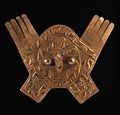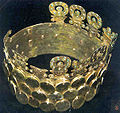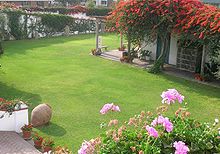Museo Arqueológico Rafael Larco Herrera
The Museo Arqueológico Rafael Larco Herrera in Lima is a museum in Peru .
Museum data
The Larco Museum is located 15 minutes from the historic center of Lima in the Pueblo Libre area. The museum building is a large property built during the time of Peru's viceroyalty and stands on the remains of a pyramid from the 7th century. The white building is built in the typical architecture of the city of Trujillo from the 18th century. It houses a collection of pre-Columbian art, which with its 45,000 exhibits covers 4,000 years of history. The pieces in the collection are varied in nature: There are sculptures, textiles, ceramics and jewelry from different pre-Columbian civilizations in Peru. Although the museum is mainly known for its Moche collection, it also contains a wide range of Cupisnique , Lambayeque , Virú , Chimú and Inca exhibits. The galleries are arranged chronologically and historically, and end with a collection of erotic art objects that are very popular with visitors. The Larco Museum is one of the few museums in the world whose warehouse is also open to the public.
history
The museum was founded in Trujillo in 1926 and moved to Lima in 1962. It mainly exhibits the collection of the Peruvian archaeologist Rafael Larco Hoyle , who named the museum after his father, Rafael Larco Herrera, under whose influence he began to be interested in the archeology of Peru. Rafael Larco Herrera himself owned a collection of pre-Columbian artifacts from northern Peru, which he later bequeathed to his son.
He quickly enlarged his father's collection by buying objects that came mainly from the north of the country, such as the Río Chicana Valley and other valleys near Trujillo, as well as the Río Virú valley or from Chimbote . In 1926 he began to exhibit his pieces on the family estate, a sugar cane plantation in Chiclin, under the name Muséo Rafael Larco Herrera .
Other private collectibles were later added, but when classifying the objects, Rafael Larco Hoyle noticed that many of them did not have the same distinctive features. At that point he decided to do his own research. Therefore, he undertook important excavations in the Virú Valley and its surroundings. He discovered the Cupisnique, Salinar, Virú, and Lambayeque civilizations, and became the great "developer" of the Mochicas . In 1949 the Larco family was forced to move to Lima. There he had the museum built to ensure the continued existence of his collection.
The new premises contain all the material (locks, beams, etc.) of the former building. The museum is privately owned and is not financed by the state. It originally comprised six exhibition rooms, a vault for displaying gold and silver artefacts, eleven storage rooms, four offices, a laboratory, a studio, a garden, a conference room and a terrace for larger stone objects. When Larco died in 1966, the museum already had more than 40,000 exhibits. In 2009 it will be completely renovated and enlarged.
Today the museum is run by Rafael Larco Hoyle's grandson Andrés Alvarez Calderón, who is entirely dedicated to preserving the family heritage. The Museo Arqueológico Rafael Larco Herrera is the result of a unique family collaboration. Today the museum is a complex of 13 halls arranged geographically and chronologically.
Permanent exhibition
The entrance to the museum has the characteristic features of a Latin American hacienda. Visitors are greeted there by the song of the official museum canary. In the middle of the courtyard is a lúcuma tree , a typical Peruvian fruit tree . The first room tells the story of the museum's founder, summarizes the archaeological and geographical characteristics of Peru and provides a chronological overview of the different civilizations of Peru. The following rooms are dedicated to the different cultures of the four regions of the country.
- North: Cupisnique , Virú , Salinar , Vicús , Mochica , Lambayeque , Chimú and Inka .
- Center: Lima , Chancay and Inka.
- South: Paracas , Nazca , Chinca and Inka.
- La Sierra: Chavin , Huari , Chachapoya and Inka.
The majority of the ceramics are from the Mochica period. A whole room shows the rituals of the sacrificial ceremonies of the Mochicas.
There are also many gold pieces in the Museo Larco. For example, an ensemble of gold forehead jewelry. It comes from the Chimu period (1300–1532) and has a lateral ornamentation that resembles the feather wings of birds. The main pattern of the forehead decoration consists of a cat's head with a bird's beak. Snakes hang from his ear pegs.
World exhibition
The museum also presents its exhibits to other museums around the world. Over 5 million viewers have already been able to admire pieces from the museum's collection. This practice was long uncommon in Peru and the Larco Museum was the first museum to start lending exhibits in the 1990s.
Conservation and restoration
A group of museum employees is responsible for the conservation and restoration of the finds. With over 80 years of experience, it has a reputation for being one of the most prestigious in the country. The team also contributes to the conservation and restoration of other public, but also private collectibles, and works together with archaeological projects and institutions.
The museum café and boutiques
There is a café-restaurant in the museum, where drinks as well as Peruvian and European dishes are offered. This is located in a garden that won the 2009 “Lima's Most Beautiful Garden” award and was founded by the Peruvian chef Gastón Acurio. The interior architecture was designed by the architect Jordi Puig. Replicas of objects on display, jewelry and clothing from the Andes are sold in boutiques .
Web links
- Official website (Spanish, English and French.).
Individual evidence
Coordinates: 12 ° 4 ′ 21 ″ S , 77 ° 4 ′ 15.1 ″ W.





